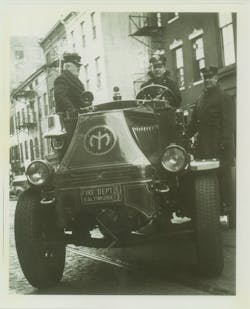Rekindles 4/12
MARYSVILLE, WA: APRIL 4, 1912 – About 7 o’clock in the evening, fire was discovered on the second floor of the Anderson Building, just over the entrance to the Star Theatre. Within a short time, the entire population was on scene to watch the fire department battle the flames. As the fire was being fought, many valuables were carried to safety by firemen, including the piano from the Star Theatre.
TARRYTOWN, NY: APRIL 4, 1912 – An explosion in an oil storage room of a hardware store started and fed a dramatic fire. The first explosion set fire to the room, causing the owner to evacuate the store of occupants. As he and a woman were fleeing, a second explosion occurred, this time caused by a powder keg, and threw the two people outside the building. The owner was trapped under a large section of collapsed wall and the woman was slightly burned. The owner was pulled clear as the first fire unit rolled in. The flames spread with amazing speed and were taking control of the entire three-story brick structure at Depot Square and Main Street. Firemen battled the flames for three hours before bringing it under control.
SALEM, NJ: APRIL 7, 1912 – A fire started that started in a knitting mill and was fanned by high winds threatened the entire town. Flames leaped from the mill, igniting the opera house, a marble works, a school, a furniture store, a livery stable and a home. The fire was becoming so large the commander of nearby Fort Mott army post sent the fort’s firefighters four miles to battle the fire.
BECKLEY, WV: APRIL 14, 1912 – Fire broke out early Sunday morning in the rear of the Rose & Turner Co.’s building at Heber and Neville streets. The building contained a large stock of furniture and other flammables. The fire bell, installed on March 28, was rung to call out the volunteer firemen. As they arrived pulling their hose reel and wagon, they faced an awesome sight: a large body of fire that was quickly spreading in both directions. Flames leaped the street and exposures in every direction were burning briskly. The heat was becoming so intense that the electric wires were burning and falling and even the concrete sidewalks were being destroyed. In all, 30 buildings in a two-block square were destroyed, including the hose house.
WATERBURY, CT: APRIL 22, 1912 – Twelve fires, each apparently of incendiary origin, occurred here between 1:55 and 9:35 P.M. One fire destroyed the old City Hall. At that fire, Fireman James Mitchell was seriously injured when the water tower he was working on toppled over. Mitchell had been at the top of the tower, 75 feet in the air, when it overturned and fell into electric wires before crashing to the ground. The fireman had fallen 60 feet and was nestled semi-conscious in a tangle of wires. Other firemen used ladders to rescue him and he was rushed to the hospital. The flames ate through City Hall and into the police station and fire department headquarters before being extinguished.
NEW YORK CITY: APRIL 25, 1912 – Battalion Chief John Rush was driving his fire department buggy from the Fifth Battalion headquarters home for lunch. Beside him was his aide, Fireman John Harvey. As they passed a stopped truck, a buggy wheel struck the truck and frightened the chief’s horse. The panicked horse bolted up Hudson Street and the chief could not control the galloping animal. As they reached Christopher Street, Rush saw children about to cross the street. Realizing he would run into them, he pulled all his weight against the reins and pulled the horse’s head to the side, tipping the buggy. Both men were thrown to the street. The chief died two hours later in the hospital. The children were not harmed.
PITTSBURGH, PA: APRIL 26, 1912 – Flames starting in the rear of a switchboard quickly spread, destroying the old Academy of Music, a popular playhouse for 40 years. The clamor of the arriving engines aroused guests in the nearby Seventh Avenue Hotel and many of them fled their rooms and assembled in the lobby. The hotel was not damaged, but three firemen were injured battling the blaze.
LOCKE, NY: APRIL 26, 1912 – Flames broke out in the Fountain House at noon. The town’s small hand chemical engine responded and did what it could, but the fire was being fanned by strong south winds and was soon raging out of control. Help was requested to the Auburn Fire Department, which dispatched a steam pumper and hose wagon that were delivered by train. In all, 16 houses and stores, the schoolhouse, a Methodist church and parsonage, seven barns and a number of smaller buildings were destroyed.
WELLSBURG, NY: APRIL 27, 1912 – Sparks from a passing locomotive ignited a fire that wiped out the business district of this town about six miles south of Elmira. Two hotels, three general stores, two feed mills, a carriage factory and five homes were lost to the flames. The village reservoir was being cleaned at the time, leaving the town without water for firefighting.
DAMASCUS, SYRIA: April 28, 1912 – Fire broke out in the great bazaar quarters within this walled city and burned for more than 30 hours. Several lives were lost, many people were injured and damage was estimated at $10 million.
CROGHAN, NY: APRIL 30, 1912 – A backyard bonfire behind a cafe apparently got out of control around 2:30 in the afternoon. As the fire extended into the building, it trapped two children in their apartment above. Their mother tried frantically to reach them, but was burned and overcome by smoke. A man pulled her to safety, then removed the children, but it was too late. They both died. The flames then extended from the building and were swept by strong winds along Main Street. In all, 32 buildings were destroyed.
